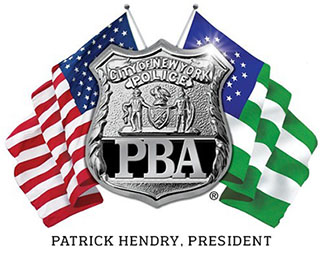





CONTACT:
John Nuthall
212-298-9187
As the first tower fell, Police Officer Alonzo Harris ran from his traffic control post at Liberty and Church Streets towards Broadway where he dove under a vehicle and was buried in debris. That day he wrapped his uniform in several plastic bags and put it in the bottom of his closet. Following the only few sick days he had taken in his nine years as a police officer he worked for over 700 hours during the rescue, recovery and cleanup of the WTC. Suffering with diminishing pulmonary function and having found nodules on his lungs, he sent the uniform he wore on 9/11/01 for testing to find it was covered with dangerous carcinogens and toxins.
PBA President Patrick J. Lynch said: “The formula is clear and simple: a vast array of carcinogens plus extended exposure equals dead and dying police officers. Sixty-five police officers have already died from 9/11 related cancers, 297 others have been diagnosed and sadly, there will be many more to come. Officer Harris lives not only with a serious diminishment in lung capacity, but with the well-founded fear of cancer from WTC exposure shared by all those who served without question. Today, we are demanding the immediate release by the NYPD of statistics that demonstrates the rate of cancer occurrence in police officers who were exposed during the rescue, cleanup and recovery of the WTC. We simply cannot wait for scientific certainty to catch up to common sense. It is imperative that the rate of cancer among police officers be provided immediately so that the Federal government can have this critical information while it considers adding cancer to the list of illnesses covered by the Zadroga Act.”
Dr. Richard J. Lee said: “The chemicals found in the WTC Dust can each, at sufficient exposure levels, cause various harmful effects on the body, including direct irritation of tissues of the eyes, nasal passages and bronchial tubes in the lungs, and after absorption into the body, effects on the nervous system and kidneys, and various types of cancer.”
Assembly Member Micah Kellner (D-Upper East Side, Yorkville, Roosevelt Island) said: “We owe it to our finest to find out if those working at Ground Zero in the weeks and months after 9/11 suffer from higher rates of cancer. The Mayor’s refusal to release the NYPD list is nothing short of shameful. There is no time to waste-- police officers’ lives are counting on it.”
State Senator Diane J. Savino said: “As I said earlier this week, I find this whole situation outrageous. We are calling on the City of New York to allow Mt. Sinai Medical Center access to the list of police officers who worked at Ground Zero the days and months after the attack. These data could help those members of New York’s Finest finally get the help they need from the Federal government. The City needs to find a way to protect the privacy of these individuals while allowing for the appropriate institutions to have the data that can save lives.”
PBA president Patrick J. Lynch extended that gratitude of his 23,000 members to Assemblyman Kellner and Senator Savino for drafting this important legislation and to Dr. Richard Lee, a nationally recognized forensics expert, for the support of RJ Lee Group. See Dr. Lee's statement, below.
###
Laboratory testing of Officer Harris' clothing worn on the morning of Sept 11, 2001 while he responded to the disaster clearly demonstrates the presence of what is now referred to as World Trade Center Dust (WTC Dust). The contaminants found in the dust were created by the extreme forces acting on building materials such as insulation during the collapse of the buildings, and by the ensuing fires that consumed the spilled fuels, building contents and construction materials. The WTC Dust is a unique mixture of a wide variety of physical and chemical components, and include heavy metals, asbestos, fine concrete particles, and chemicals produced by burning, including polycyclic aromatic hydrocarbons and dioxins/furans. The chemicals found in the WTC Dust can each, at sufficient exposure levels, cause various harmful effects on the body, including direct irritation of tissues of the eyes, nasal passages and bronchial tubes in the lungs, and after absorption into the body, effects on the nervous system and kidneys, and various types of cancer.
The WTC Dust has been extensively studied. These investigations have shown that the unique physical and chemical characteristics of the Dust increase the likelihood of toxic effects. For example, the heavy metal lead found in the Dust is more easily absorbed into the body compared to lead found in other environmental sources. The Dust also contains a higher percentage of long and very thin asbestos fibers than is found in other asbestos-contaminated buildings. Longer asbestos fibers have been shown to produce greater toxicity. In fact, asbestos fibers found in the WTC Dust collected from surviving buildings around the World Trade Center are expected to be about three to 50 times more toxic than the asbestos fibers from other asbestos-containing buildings. Importantly, these long and thin fibers were found on Officer Harris' clothing. There has also been concern expressed by the United States Environmental Protection Agency and other organizations that the combination of contaminants found in the WTC Dusts have the potential to act together to increase toxic effects as compared to the contaminants when found alone.
RJ Lee Group is a leading industrial forensics firm. They and their partner firms provide laboratory analysis, Industrial Hygiene, and Toxicology services. They are routinely called in to support and investigate major disasters. They were involved in the the most comprehensive investigation and assessment of the composition, toxicology and potential health risks of the dust cloud caused by the World Trade Center Disaster. They have also been involved in disaster recovery efforts of other major events including Hurricane Katrina and the DeepWater Horizon explosion in the Gulf of Mexico.
RJ Lee Group, Inc, 350 Hochberg Road, Monroeville, PA 15146 724-325-1776